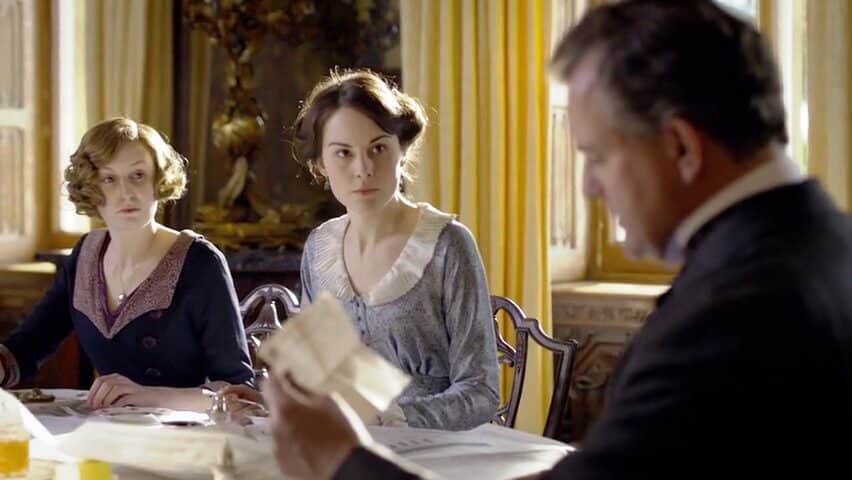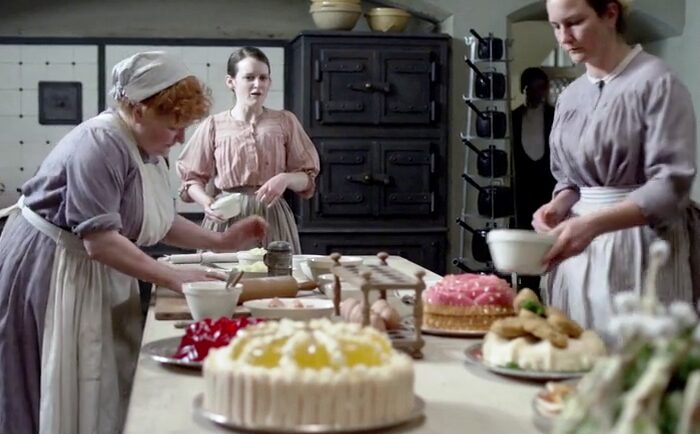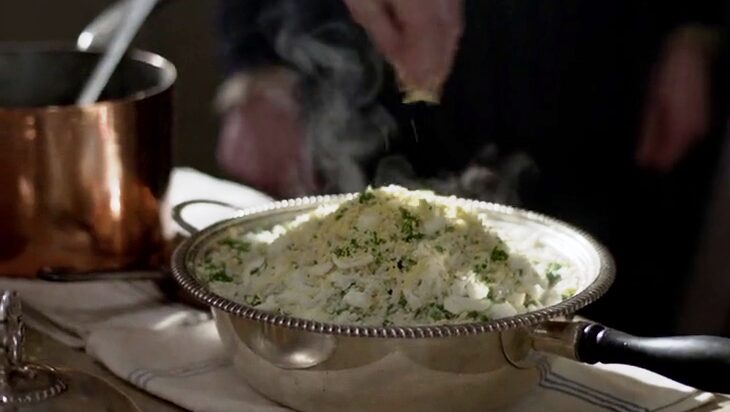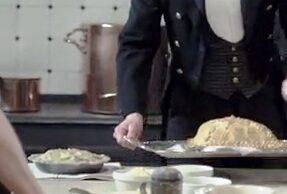
Downton Abbey is seen in over 100 countries around the world. This week BBC launched the series in South Africa (Sunday nights), and in Canada Vision TV is broadcasting the series on Wednesdays.
Many of us around the world have seen all episodes (there are two seasons), but it really is great to relive the series again, right from the beginning. There is so much which is missed the first time. Plus, it kills time while waiting for Season 3.
Our introduction to Downton Abbey is informal, and comes early in the first episode. While upstairs the Crawleys are still nestled in their beds, there is a flurry of activity down below. In our introduction to the grand home, we see the engine that drives it all. The maids rise at 6:00 am to open the drapes, dust furniture, tend to flower vases. William, the footman, irons the newspapers for the Lord and Lady. Daisy, the scullery maid, lights fires in the various fireplaces around the house, as well as the kitchen stove (horrors). The first round of duties appears to be done. The servants scurry back downstairs and out of sight, gathering for breakfast, a rack of servant bells behind them. A breakfast tray is sent upstairs, others will congregrate for dining.
How Titanic Affects Downton Abbey

So while three Crawleys (Cora lingers in her room) discuss the news of Titanic over breakfast, a lone cyclist is making his way to Downton. The opening shot in this episode is the tapping of a telegraph, which turns out to be news of the Titanic which directly impacts the Crawley family. Reading the news from freshly ironed papers, Lord Grantham observes: “Every mountain is unclimbable until someone climbs it, so the ship is unsinkable until it sinks.” It would soon become apparent that for the Crawleys, every fortune is safe until it is not. Unbeknowst to the family, Robert’s cousin James Crawley and his son Patrick were passengers on Titanic. The unthinkable happened: two heirs were lost at sea. My father (a lawyer) would be proud of the attention to client service: solicitors in New York were very quick to relay the devasting news–well, as fast as telegraphs and bicycles could manage in those days.
Cynics may roll their eyes at the convenient timing of events. April 14th, 2012 marks the 100th anniversary (check my posted menus/recipes for 1st, 2nd and steerage classes if you want to plan your own tribute) Julian Fellowes (creator) confirms that we are given a definitive point in history which we can immediately comprehend. Saves time to spend on developing the character story lines.
What is an EntaiL, Anyway?
While my undergraduate degree is in History, it was part of a Pre-Law program, so I should be able to explain this whole mess. In short, Robert, the current 6th Earl of Grantham, married Cora for her money to keep Downton afloat. Don’t worry that have been happy ever since. In a clever move, his father (the 5th Earl) wanted to ensure that her money would not be able to be detached from the beloved Downton Estate, so created the entail to bind the two. For more information check out Promatica’s blog which goes into much more depth. Property law is one of the less exciting law classes so an appropriate title: Downton Abbey Fans – Welcome to the MOST Boring Law School Class
The details of the entail were not unknown to the Crawleys. Should Cora have given birth to a male child, all would have been swell as the child would have been the heir. Alas, women didn’t count when it comes to the laws of inheritance in those days. As you can see, the couple have 3 lovely daughters. As a back up, Mary was engaged to cousin Patrick in case something better didn’t come along. As commoners, we are somehow comforted in knowing that the rich have troubles too. What it comes down to is this. Change does not come easily to many, and the unknown heir is seen as a threat. The story line is a great analogy for all the changes that was to occur in this period of history.
The Food of Downton Abbey

There are many reasons to love Downton: the costumes, the opulence, the formality, specific characters. The Dowager Countess is a favorite, and if you tweet, you will love @theladygrantham who lives in Yorkshire and who stays very much in character.
For me, and other foodies, we just can’t help ourselves: it is the food which is so fascinating. I immediately fell in love with Mrs. Patmore, who reminds me of my grandmother–and I–her Daisy. Just look at this picture of lovely desserts, but talk about time warp. Certain foods do fall in and out of fashion, and they loved their jello back in the day. Bon Appetit blogged that it was both disgusted and amused. While aspics and jello molds have had their day, you may wish to serve wine jello between courses at your dinner party. It was served on the Titanic. I have posted a wine jello recipe which my friend gave to me who got it from a relative. It is “quite lovely” as I said in the radio interview I gave last week.
I learned to cook from my grandmother (my own Mrs. Patmore) and proudly carry the food traditions of our European heritage with me. My degree in history also further fuels my curiousity, not just about the period, but about how people actually lived. What were the differences in diet between the upper and lower classes, what food was available at that time and how was it prepared? Which dishes are still prepared to day, handed down from generation to generation? Food and communal dining, has and always will, play a role in bringing people together. There is a big push these days to get families to sit around the dinner table to rebuild the bonds in a frantic world.
I have been interested in looking at the period to gain a better understanding of food of that period. The launching point for this blog was a post on the ITV Food page back in October. I already have a pretty good idea of how the servants ate (confirmed in the itv article link) since I already make a mean stew and hearty soups which I learned from my grandmother.
Kedgeree

The first dish we get to see is Kedgeree. This dish originated in India, based on khishri, and brought back to the UK by the British Colonials, introducing it as a breakfast dish in the Victorian era. The Brits do love their indian cuisine.
It is a practical dish which, before refrigeration, allowed cooks to use leftovers from the night before to make into hearty and appealing breakfast dishes. Essentially the ingredients are boiled rice, chopped hard-boiled egg, cold minced fish, fried in one pan and flavored with your favorite herbs. I should think this will be great for us to have on hand up at the cottage.
As this is essentially a very simple dish with tons of variations, here is a link to simple version I have previously posted, as it might have been served at Downton, and some alternatives.
Pie Pastry

Amongst the food spotted in Mrs. Patmore’s kitchen, was an apple tart and meat pie. Both were made with a pie crust. They did make their own puff pastry, but for today we will stick with the food as it was prepared.
I am all about heart healthy eating, and pie is a sometimes food. As for myself I think of pie crust as the wrapping on the present which I discard and simply enjoy the contents.
Pie Crust
Plentiful Flaky Pie Crusts to Feed Any Crowd
Ingredients
- 5 1/2 cups unbleached all purpose flour
- 1 tsp. baking powder
- 1 large egg
- 1 lb. lard shortening
- 2 tbsp. vinegar
Instructions
- Shift dry ingredients. Cut in shortening with a pastry blender or two forks.
- Put egg and vinegar in a measuring cup and fill to 3/4 cup with cold water.
- Mix dry ingredients and make a dough. Use your hands or a food processor. It isn't particularly fussy to work with and you will end up with a lovely flaky crust.
- Divide the dough into discs and refrigerate for at least an hour before using. You can easily freeze what you don't use for future pie happy times.
Notes


